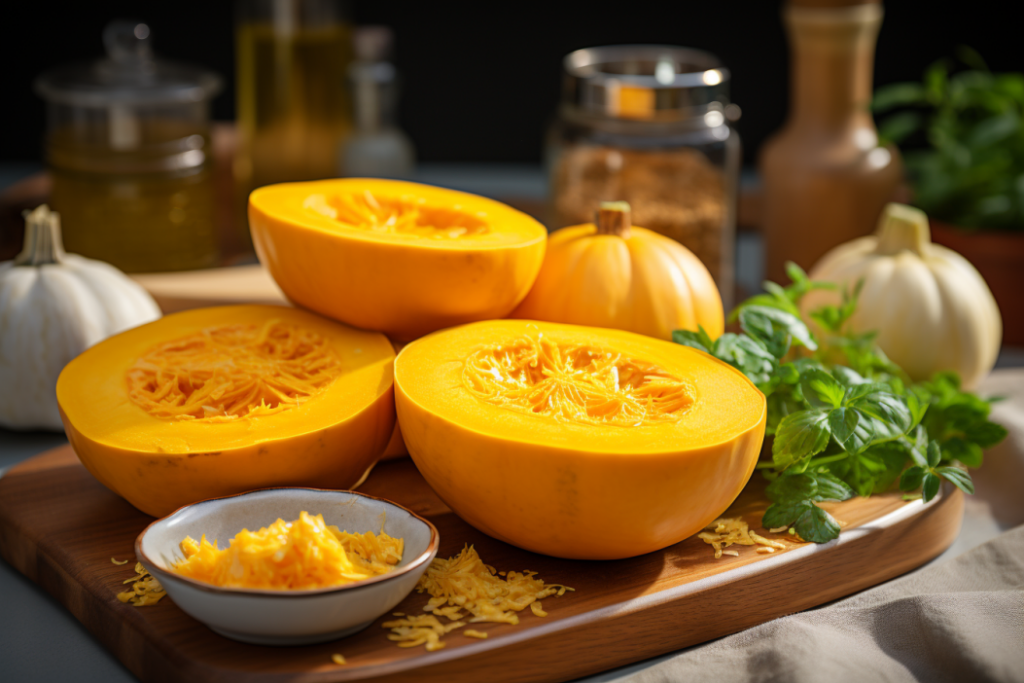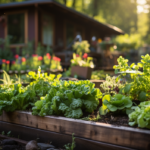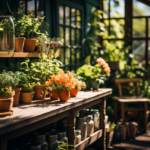Table of Contents
Learn the Best Tips and Techniques for Cultivating Healthy and Abundant Squash Plants in Your Backyard
If you love gardening, growing squash is an excellent option to include in your home garden. Squash is easy to grow, and it’s one of the most favorite vegetables worldwide. Most people prefer to grow squash because it’s nutritious and perfect for making different dishes. Whether you’re growing zucchinis, summer squashes or pumpkins, there are a few essential things that you need to know about cultivating this vegetable in your backyard. In this article, we will give you some tips and tricks to help you grow healthy and robust squash plants in your home garden without breaking a sweat.
Choosing the Right Squash Variety for Your Garden
One of the fundamental things to consider before planting squash in your home garden is selecting the right variety to grow. Squash comes in various types and varieties, including summer, winter, and pumpkin squash, among others. Choosing the right variety is essential to ensure you get the best harvest possible. In this section, we’ll discuss some essential factors to consider when choosing the right squash for your garden.
Growing Season
Different squash varieties have varying growing seasons. Some squash plants take longer to mature than others. For instance, summer squash takes roughly two months to mature, while winter squash may take up to five months, from planting to harvesting. It’s crucial to consider the growing season of a squash variety to ensure it fits your garden schedule.
Available Space
Consider the amount of space that you have available in your home garden when choosing a squash variety. Some squash plants grow horizontally, while others are more compact and can grow vertically. For example, bush summer squash plants grow low to the ground, making them ideal for container gardens, while vining winter squash species require considerable space to spread out.
Weather Conditions
Squash plants are sensitive to temperature and moisture levels. Some squash species thrive in warm and sunny conditions while others may not do so well if the weather is too hot. On the other hand, some species do well in colder weather conditions. Consider the weather in your region to select a squash variety that will thrive in your garden’s environmental conditions.
Personal Preferences
The type of squash you grow can significantly affect its texture, flavor, and color. Select a squash variety based on your personal preferences for taste and cooking. For example, Butternut squash makes an excellent soup base and roasts well. Meanwhile, Acorn squash is perfect for stuffing and baking.
Choosing the right squash variety for your home garden is essential to ensure you have a healthy and abundant harvest. When selecting a variety, consider its growing season, available space, weather conditions, and personal preferences. With this guide, you are assured of picking the right squash species that will flourish in your garden while providing you with tasty and nutritious meals.
Preparing the Soil for Squash Planting
Before you start planting squash, you need to ensure that the soil is ready to provide the best environment for your plant to thrive. Here are some essential aspects to consider when preparing your garden soil for squash planting:
Selecting the Right Location
To grow a healthy squash plant, it needs enough sunlight and the right amount of water. Select an area in your garden that gets at least 6 hours of sunlight every day. The soil should also be well-drained so that it doesn’t hold too much water, which can lead to root rot. It’s also good to plant squash close to other plants like cucumbers or corn because they act as natural repellents for pests.
Amending the Soil
Soil amendments can improve the soil’s quality, providing the ideal environment for squash to grow. Adding organic compost, like manure, to the soil can provide the necessary nutrients for your plant to thrive. Ideally, you want the soil to have a pH of 6.0 to 6.5 – slightly acidic.
Loosening the Soil
Squash needs loose, well-aerated soil to grow healthily. To promote good soil drainage and aeration, till the soil before planting. This will allow the soil to absorb moisture and nutrients.
Adding Mulch
Adding a layer of mulch is an excellent way to retain moisture and prevent weeds from growing around your squash plants. A layer of grass clippings, leaves, straw, or wood chips can do the job.
Preparing the soil is crucial to successfully grow squash in your garden. Choosing the right location, amending the soil, loosening the soil, and adding mulch are essential steps that should be taken. By following these tips, your squash plants can get the right nutrients and moisture they need to yield an abundant harvest.
Planting Squash Seeds and Seedlings
Planting squash seeds and seedlings is a crucial aspect of growing squash in your home garden. You need to plant them at the right time, in the right location, and by following the necessary steps. In this section, we look at what you need to know about planting squash seeds and seedlings.
Timing for Planting Squash
Choosing the right time to plant squash seeds and seedlings is crucial for success. Squash plants are susceptible to frost, so it’s important to wait until there is no risk of frost. The ideal soil temperature for planting is between 60°F and 105°F, with 70°F being the optimum temperature. Squash seeds usually take 5 to 10 days to germinate successfully, and once they do, they grow rapidly.
Location for Planting Squash
Squash plants require a sunny location with fertile and well-drained soil. Therefore, it is best to plant them in an area that receives at least six hours of sunlight each day. Also, squash plants are vine plants, and they will spread out in different directions. So, it’s essential to allow enough space for them to grow. You should plant seeds or seedlings 24 to 36 inches apart in well-prepared soil.
Planting Squash Seeds
Planting squash seeds is simple and straightforward. Dig plant holes with a depth of 1 inch to 1.5 inches. Ensure that the holes are spaced apart at the recommended distance. Then, place one or two seeds in each hole and cover them with soil. Water the seeds after planting to help them settle into the soil. You can thin the rows to the recommended spacing once the plants start to grow.
Planting Squash Seedlings
If you plan to plant squash seedlings, it’s essential to ensure that they are healthy and free from diseases. Make sure that you transplant seedlings when the weather is appropriate and the soil is moist. Dig holes in the planting area, each larger than the pot or container. Then, gently take out the seedlings from their pots and place them in the holes. Fill the gaps around the seedlings with soil and press down slightly. Water the seedlings after planting to help them settle into the ground.
In conclusion, planting squash seeds and seedlings are essential aspects of growing squash in your home garden. By following these basic steps, you can plant them at the right time, in the right location, and with the correct spacing to guarantee healthy and abundant plants.
Watering and Fertilizing Squash Plants
Squash plants are among the most productive plants and are relatively easy to grow. However, it is essential to provide them with enough water and nutrients to ensure that they grow healthy and produce a bountiful harvest. Here are some tips on watering and fertilizing squash plants:
Watering Squash Plants
Squash plants require plenty of water to grow. However, overwatering can lead to several problems such as root rot, fungal infections, and reduced growth. Below are some watering tips for your squash plants:
- Water your squash plants deeply once or twice a week during the growing season.
- Water them in the morning to allow the leaves to dry before evening, which prevents fungal infections.
- Avoid getting foliage wet when watering to decrease the chances of fungal diseases.
Fertilizing Squash Plants
Squash plants require plenty of nutrients to grow healthy, and they can quickly deplete the available soil nutrients. Here are some tips on fertilizing squash plants:
- Fertilize your squash plants with a balanced fertilizer with equal amounts of nitrogen, phosphorus, and potassium.
- Apply the fertilizer to the soil when planting.
- You can apply a side dressing of nitrogen-rich fertilizer when the squash begins to flower to boost its growth.
- Use organic compost during the growing season to provide additional nutrients to the soil.
In conclusion, watering and fertilizing are crucial aspects of growing a successful squash garden. Squash plants require adequate water and soil nutrients to grow healthy and produce a healthy harvest. Follow the tips mentioned above on watering and fertilizing squash to ensure that your plants thrive and produce an abundance of flavorful squash fruits.
Pruning and Treating Squash Pests and Diseases
Squash plants, like any other plants, are prone to disease and pests. While it’s not always possible to prevent them, there are a few measures you can take to minimize the damage on your squash plants. Regular pruning, along with the use of organic pesticides, is one way to keep your squash plants healthy and fruitful, while controlling pests and diseases.
Pruning Squash Plants
Pruning squash plants involves removing extra leaves, stems, and other growths to ensure that the plant remains healthy and produces a bountiful harvest. The best time to prune your squash plant is early in the morning or late in the evening when the sun is not too hot.
Here are some essential tips and techniques for pruning your squash plants:
- Remove any dead or diseased leaves and stems from the plant. This helps to prevent further damage from insects and diseases.
- Cut off any branches that may be crowding the growth of other squash plants.
- Trim the long vines to encourage bushier growth and increase yields.
- Make sure to disinfect your pruning shears or scissors before you start to avoid the spread of diseases.
Treating Squash Pests and Diseases
Proper garden maintenance, including watering, fertilizing and pruning, is the most effective measure to prevent pests and diseases in squash plants. But despite best efforts, squash bugs, aphids, and fungal diseases can still affect your plants. Here are some common pests and diseases that affect squash plants and how to treat them:
Squash Bugs
These bugs are a common problem in squash plants. They suck the sap from the leaves and stems, causing the leaves to wilt. Here’s how to control squash bugs:
- Regularly remove any eggs found on the leaves, which resemble small, bronze-colored, bullet-shaped objects.
- Use a bag or duct tape to catch adult squash bugs.
- Neem oil spray can be an effective organic insecticide to control squash bugs.
Aphids
Aphids are tiny insects that thrive on the undersides of leaves, causing them to curl. Here’s how to control them:
- Hose down the plant regularly to knock off the aphids.
- You can also use insecticidal soap to remove them.
Fungal Diseases
Fungal diseases such as powdery mildew are also common in squash plants. Here are some techniques to prevent and control them:
- Plant squash in well-draining soil to reduce the likelihood of fungal diseases.
- Water the soil, not the leaves, to prevent the spread of the disease.
- Prune off infected leaves and discard them.
In conclusion, maintaining healthy squash plants is critical to ensure a fruitful harvest. By regularly pruning and treating pests and diseases, you can help your squash plants grow and flourish all season long.
Harvesting and Storing Squash for Longer Freshness
Squash is a versatile vegetable that can be used in several dishes, from savory recipes to sweet treats. Harvesting and storing your squash properly ensures that you enjoy healthy and delicious vegetables throughout the season. In this article, we will discuss some essential tips for harvesting and storing squash for longer freshness.
Harvesting Squash
Harvesting your squash at the right time is crucial to maintaining its quality. If you wait too long, the squash can become overripe and mushy, making it unsuitable for consumption. Underripe squash, on the other hand, won’t have developed the sugars essential to give them their sweet flavor. Here are some tips for harvesting squash:
- Observe the squash’s color: Summer squash should have a bright color with a shiny skin. If the skin appears dull with a yellow tint, it’s probably overripe. For winter squash, the skin should be tough and unable to be punctured with your fingernail when it’s ready to harvest.
- Check the stem: The plant’s stem should be firm and not easily bend when you attempt to cut the squash.
- Use a sharp knife: It’s best to use a sharp knife or pruning shear to cut the squash from the stem. This prevents damaging the vine or accidentally picking other squash.
Storing Squash
After harvesting, it’s time to store your squash to stay fresh for as long as possible. Proper storage keeps the squash’s flavor, texture and prevents them from spoiling quickly. Here are some tips for storing squash:
- Clean the squash: Remove any dirt or debris from the surface of the squash using a soft brush or a clean cloth.
- Dry the squash: Let the squash dry for a few hours or overnight before storing it to prevent moisture buildup that can lead to rotting.
- Store in a cool and dark place: Squash prefers cool temperatures ranging between 55-60F, so the ideal place is a cool pantry, cellar, or a spot in the basement. Avoid storing squash close to sunlight or heat sources.
- Don’t stack the squash: Placing the squash directly on top of each other can cause bruising, which quickens the spoiling process.
By following these tips, you can enjoy fresh and tasty squash well beyond harvest season. Proper harvesting and storage are essential for maintaining the quality for longer freshness.
Conclusion
Growing squash in your home garden is not only satisfying but also an excellent way to provide fresh and healthy vegetables for your family. By following these essential tips and techniques, you can cultivate healthy and productive squash plants with ease. Just remember to choose the right variety, prepare the soil correctly, water and fertilize the plants properly and take care of pests and diseases. Finally, harvest your juicy squash at the right time and store them for longer freshness. With time, patience and practice, you will be well on your way to enjoying the freshest and most nutritious squash dishes straight from your home garden. So, get gardening, and happy squash growing!









